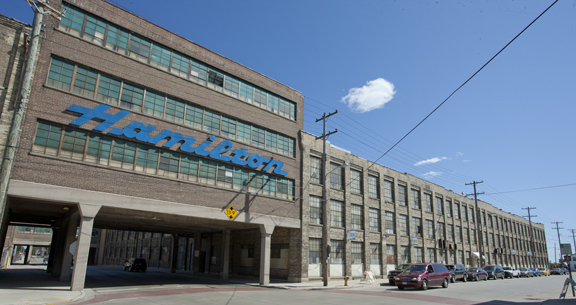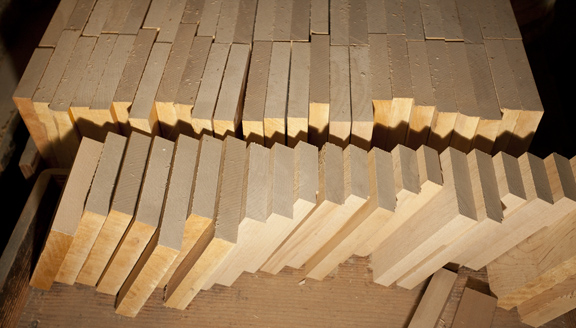The smokestack of the Hamilton Wood Type Manufacturing Company. This beautiful brick stack stands above the factory that once produced type and cabinets for printers. Today, the building houses the Hamilton Wood Type Museum.
I spent an extra day in the midwest after GraphExpo last week. A friend and I drove four hours north of Chicago to Two Rivers, Wisconsin, to visit the Hamilton Wood Type Museum.
The Hamilton factory dominates the town of Two Rivers, Wisconsin.
The building is a formidable 19th (and early 20th) century manufacturing plant the size of a city block, with a giant smokestack with Hamilton Mfg Co spelled in white bricks. The three-story facility is still a working factory, used by a company called Fisher-Hamilton, which manufactures laboratory furniture and chemical fume hoods. Apparently a few dozen people still work in the Two Rivers plant building these products.
The first floor on the south end of the factory is now occupied by the Hamilton Wood Type Museum, the remains of what was once a huge manufacturing operation that made wood type, type cabinets, type drawers, furniture, and all of the accoutrements of a letterpress printing plant.
Blocks of type-high maple are stacked in the museum, adjacent to the pantograph-router, where letters are cut from patterns.
The business was founded in the year 1880 by James Edward Hamilton (incorporated in 1889), who went by the nickname Ed. He began his business in type-making when the local job printer asked him to make some wood letters for a poster. The type he made was successful, and he was asked to make more.
Hamilton’s first work in type-making was with Holly, which he cut with a scroll saw and laminated on a wooden base to make it type-high. His type was called Holly Wood Type, and he went into competition with the east coast type manufacturers Tubbs, Wells and others who were making type out of end-grain maple and other hardwoods. Hamilton’s laminate Holly Wood Type was comparable to, or better than his competitors’ offerings, and he made a name for himself among the nation’s printers.
In the center is a wood type pattern. The pantograph follower chases the pattern (operated by hand), as the router cuts the same letter in a block of maple 18 inches to the right. The pantograph allows the pattern to be scaled, making it possible to make various sizes of type from a single pattern set.
Ed Hamilton was also very good at marketing; he worked tirelessly to sell his wood type to newspapers and job printers. He sent sample letters to potential customers, with an advertising and price sheet enclosed, and the orders started to come in.
The Hamilton Wood Type Company soon had hundreds of employees, a larger building, and began to manufacture printer’s cabinets, desks, shelves and other cabinetry needed in the printing trade. Type was the biggest part of the business, but wooden products of all types made the company the go-to organization for printers.
The router cuts the pattern of the letter into a small block of maple, making a single character of wood type.
The company’s wood type selections grew, and the volume of shipments grew also. A printer could order wood type from less than one inch in size (36 point type was typically the smallest), up to huge letters 18 or 24 inches in size.
And, Hamilton’s type was as beautiful as it was functional. Though the Holly Wood Type had been successful, Hamilton switched to the more traditional end-grain hardwood type, sanded and polished to perfection before being cut into letters.
These are the chisels used by craftspeople in the finishing of wood letters. Where the round router cutter leaves a round corner (interior), a chisel can make it sharp and angular.
The factory closed in the 1980s, and several years later the community of Two Rivers, Wisconsin, reopened it as a public museum, and an educational organization. Today, old-timers who worked in the plant come around and explain the process of making wood type to the young museum staff. This helps to keep the story of the Hamilton Wood Type Museum alive.
Though the Hamilton Wood Type Museum has each of the machines necessary to make wood type, the organization seldom makes any production quantities of type. My observation is that the planing and sanding machines on display will not work, so preparation of maple blanks for type-making would require more modern machines (perhaps located in a part of the museum not accessible to visitors?).
The pantographs used for the actual cutting of type are still in the plant, and are still functional. The two routers mounted on the pantographs in the demonstration area are powered by compressed air instead of the original steam-powered routers, and they appear to be able to make type just as Hamilton did when the plant was running (I would have loved to try it).
The museum is a wonderful place that kindles memories of letterpress printing, and encourages people to learn about the process. I have long wanted to visit the plant, and now that I have seen it, I feel as though it is a dream fulfilled.








Woderful, the museum of woodworking history.